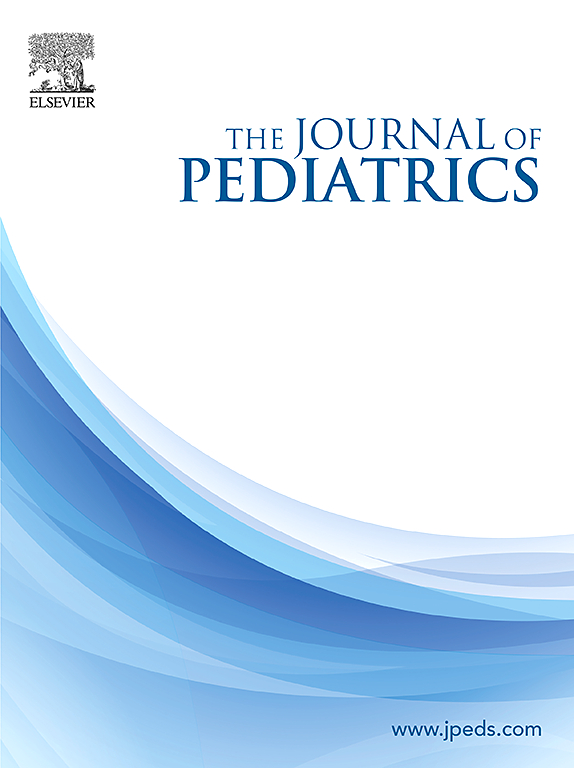Effect of Intermittent Hypoxemia and Hyperoxemia during the Neonatal Period on Control of Breathing Function among Infants Born Extremely Preterm
IF 3.9
2区 医学
Q1 PEDIATRICS
引用次数: 0
Abstract
Objective
To evaluate the association between intermittent hypoxemia (IH) and hyperoxemia (HOX) during the first 28 days with peripheral and central chemoreception at 36 weeks of postmenstrual age among infants born extremely preterm.
Study design
For this observational study, 52 infants born at 23-28 weeks of gestational age were enrolled. Mean daily IH frequency (arterial oxygen saturation <80% for ≥10 seconds) and percent of time in HOX (arterial oxygen saturation ≥98% while the fraction of inspired oxygen was >0.21) were calculated for the first 28 days of life. At 36 weeks of postmenstrual age, respiratory control tests assessed peripheral chemoreception by ventilatory response to 100% O2 for 30 seconds in which decreased ventilation caused by inhibition of peripheral chemoreceptors reflects their contribution to respiratory drive. Central chemoreception was evaluated by ventilatory response to 4% inspired CO2 for 10 minutes.
Results
Multivariable generalized linear models showed increasing IH and HOX were independently associated with an attenuated ventilatory response to 100% O2 at 36 weeks of postmenstrual age. IH and HOX were not significantly associated with an attenuated ventilatory response to CO2.
Conclusions
In these infants born extremely preterm, neonatal IH and HOX were independently associated with attenuated peripheral chemoreception at near-term corrected age. This may reflect reduced peripheral chemoreceptor oxygen sensitivity and may be in part responsible for persistence of respiratory instability in infants born preterm. Neonatal IH or HOX were not associated with reduced central chemoreception.
新生儿期间歇性低氧血症和高氧血症对极早产儿呼吸功能控制的影响。
目的:评价极早产儿经后36周外周血和中枢性化疗后28天间歇性低氧血症(IH)和高氧血症(HOX)之间的关系。研究设计:在这项观察性研究中,52名出生在23至28周的婴儿被纳入研究。计算出生后28天的平均每日IH频率(SpO22≥98%,FiO2>.21)。在经后36周(PMA)时,呼吸控制试验通过对100% O2通气反应30秒来评估外周化学感受器,其中外周化学感受器抑制导致的通气减少反映了它们对呼吸驱动的贡献。通过吸入4% CO2 10分钟的通气反应来评估中枢化学接受。结果:多变量广义线性模型显示,IH和HOX的增加与PMA 36周时100% O2通气反应的减弱独立相关。IH和HOX与CO2通气反应减弱无显著相关性。结论:在这些极早产婴儿中,新生儿间歇性低氧血症和高氧血症与近期矫正年龄外周化疗接受减弱独立相关。这可能反映了外周化学感受器氧敏感性的降低,并且可能是早产婴儿持续呼吸不稳定的部分原因。新生儿间歇性低氧血症或高氧血症与中枢化疗接受性降低无关。
本文章由计算机程序翻译,如有差异,请以英文原文为准。
求助全文
约1分钟内获得全文
求助全文
来源期刊

Journal of Pediatrics
医学-小儿科
CiteScore
6.00
自引率
2.00%
发文量
696
审稿时长
31 days
期刊介绍:
The Journal of Pediatrics is an international peer-reviewed journal that advances pediatric research and serves as a practical guide for pediatricians who manage health and diagnose and treat disorders in infants, children, and adolescents. The Journal publishes original work based on standards of excellence and expert review. The Journal seeks to publish high quality original articles that are immediately applicable to practice (basic science, translational research, evidence-based medicine), brief clinical and laboratory case reports, medical progress, expert commentary, grand rounds, insightful editorials, “classic” physical examinations, and novel insights into clinical and academic pediatric medicine related to every aspect of child health. Published monthly since 1932, The Journal of Pediatrics continues to promote the latest developments in pediatric medicine, child health, policy, and advocacy.
Topics covered in The Journal of Pediatrics include, but are not limited to:
General Pediatrics
Pediatric Subspecialties
Adolescent Medicine
Allergy and Immunology
Cardiology
Critical Care Medicine
Developmental-Behavioral Medicine
Endocrinology
Gastroenterology
Hematology-Oncology
Infectious Diseases
Neonatal-Perinatal Medicine
Nephrology
Neurology
Emergency Medicine
Pulmonology
Rheumatology
Genetics
Ethics
Health Service Research
Pediatric Hospitalist Medicine.
 求助内容:
求助内容: 应助结果提醒方式:
应助结果提醒方式:


